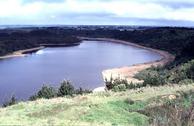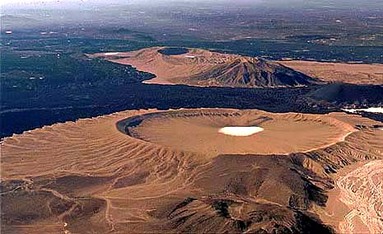|
After the sensationalist claims which have been cropping up over the last couple of days, as has been reported in the volcanism blog and the eruptions blog, I thought I would do a brief post on the volcanics in this area of Australia. The Global Volcanism Program has a brief overview of the Newer Volcanics Province (NVP for short). Overall there has been volcanic activity in this area for the past 60 million years, the NVP is associated with the volcanism in the area over the past 5 million years and hence has been termed the 'Newer Volcanics'. The area in question spreads over 15,000 km2 of central and western Victoria, and is an excellent example of intra-plate volcanism as many of the volcanic formations left behind are still visible today. Overall there are around 400 volcanic vents and shield volcanoes. They can generally be described as monogenetic in nature, which means that these volcanoes are only active from the same vent once.  From the GVP, photo of a maar. The last eruptions in this area occurred around 5500 years ago and was probably from Mount Gambier followed by a later eruption of Mount Schank 5000 years ago. In this area the volcanism is mildly explosive and effusive because of the basaltic nature of the lava. The area is dominated by large lava voluminous lava flows which have filled large valleys. Other formations in the area are scoria cones, ash/pyroclastic layers, maars and tuff rings. Maars are formed when magma comes in to contact with groundwater and explodes on contact. This creates a crater in the Earth and these commonly then fill with water, as is seen in the photo above. This type of volcanism is called phreatomagmatism. Tuff rings form by the same mechanism but do not fill with water after an event. Study in this area has not been extensive but enough has been done to understand the nature of the volcanic field and the hazards it prevents. One thing is for certain, as has been stated in other blogs (listed above), using the word overdue in volcanology is not good practice, and is a bit like a train in the UK, you never really know when it will turn up! Sources Matchan and Phillips, 2011. New 40Ar/39Ar ages for selected young (<1 Ma) basalt flows of the Newer Volcanic Province, southeastern Australia. Quaternary Geochronology 6 (3-4), pp. 356-368 Global Volcanism Program 6/6/2012 02:40:11 am
Thanks for sharing such a great information. I really enjoyed reading and expect more to come from your staff. 20/8/2012 03:15:08 am
Quality articles or reviews is the key to be a focus for the viewers to pay a visit the site, that’s what this website is providing. Comments are closed.
|
Archives
July 2023
|


 RSS Feed
RSS Feed